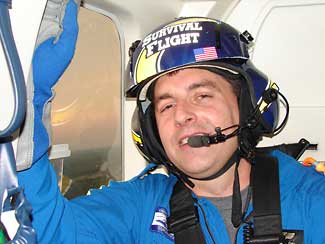In a space smaller than the average coat closet, the Survival Flight team saves hundreds of lives every year.

“There is definitely an adrenaline rush when the pager goes off,” says Jeff Thomas, flight nurse specialist. He and the team try to be skids up — flight lingo for launched — within six minutes of receiving a page for a flight.
In this short amount of time, the nurses assemble the appropriate supplies and equipment for the situation and make their way to the helipad, where they will board a Bell 430 helicopter that has just enough space for a stretchered patient, two flight nurses and specialized equipment ranging from an infant isolette to an intra-aortic balloon pump.
“When a flight is activated it is the beginning of a very complicated puzzle of physiology, interpersonal dynamics and logistics we have to constantly assess, predict and react to,” he says. “We prepare for flights every shift and every educational session.”
Since 1983 Survival Flight has extended the reach of the U-M Health System beyond the University’s borders. Staff members use helicopters, airplanes and a freightliner ambulance to provide rapid response and specialized life support to ill or injured patients 24-7.
Survival Flight also transports organs and organ transplant teams from hospital to hospital, transfers newborns and evacuates people from accident sites to the nearest trauma treatment facility.

Four years ago, while working as a neonatal pediatric nurse in Iowa, Thomas visited Michigan to take an extracorporeal membrane oxygenation (ECMO) specialist training class. After talking with someone from the Survival Flight program, his life was uprooted.
“U-M offers a flight program unlike any other in the world,” he says. “It’s a very aggressive program in terms of its management and its abilities to offer things no one else does. I thought I’d give it a try.”
Now in his third year as a flight nurse specialist whose clinical specialty is neonatal/pediatric care, Thomas often works with the Holden Neonatal Intensive Care Unit at C.S. Mott Children’s Hospital. Pediatrics constitutes about 40 percent of the flight missions.
The team averages four flights per day. Survival Flight typically flies its helicopters to cities in the lower peninsula of Michigan, completing about 1,500 flights a year, but its fixed-wing service will go anywhere in the country if needed. The farthest trip it has made thus far is to Cancun, Mexico.
Thomas recalls a shift where the team was called at 11 p.m. to an accident in a neighboring county.
“When we arrived on scene,” he says, “we departed the still-running helicopter, climbed through a ditch of hip-high weeds and made our way to the ambulance where the paramedics on scene were working to stabilize a patient who had been severely injured in a rollover motor vehicle accident.”
Only 45 minutes later, after administering drugs, placing a breathing tube into the patient’s trachea and flying him back to the hospital, Thomas was back to completing his nightly to-do list, visiting patients and authoring educational presentations.
This excitement is part of what draws him in. “You don’t know what your shift’s going to hold. You could be in a ditch somewhere or holding a tiny 1-pound baby. You never know,” he says.
“It’s a very good job for people with short attention spans because you’re always trying to focus on something new,” he jokes.
Survival Flight has faced some extraordinary challenges, especially in the last year. In June, six members of the transplant team died in a plane crash while transporting procured organs from Milwaukee. The grand opening of the new cardiovascular center less than a week later was dedicated to the selfless victims of this tragedy.
Thomas says nursing is something he has wanted to do since he was 10. His mother was a nurse, and he was captivated by the stories she’d tell him. “Once I found out what flight nursing was,” he says, “that’s basically what I wanted to do. I was a nurse for 12 years before I got this job.”
In a field where men are typically outnumbered, Thomas works in a rare nursing setting with 14 other males out of 20 total flight nurses. He recently participated in a male nurse promotional poster by the Michigan Center for Nursing.
“I saw it as an opportunity to sit down, collect my thoughts and remind myself why I was a nurse so I could help out the cause of men in nursing,” he says.
Of his team members, Thomas says, “I didn’t know how much I would enjoy working with and learning from the people I do. They are the 19 smartest people I’ve ever worked with, and they continue to push me every day.”
Thomas lives in Howell with his wife and three children.
The weekly Spotlight features staff members at the University. To nominate a candidate, please contact the Record staff at [email protected].

